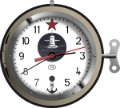 As a fan of flip clocks, I used to strongly affirm that the use of "analog" to describe a flip clock was patently wrong. A flip clock is a digital clock with an electro-mechanical time keeping mechanism. Many people asserted that since the clock did not use what we would call "digital" technology, such a clocks with integrated circuits and LED displays, but instead used mechanical time keeping, it should be called digital analog. Or in this case, an analog flip clock. Now, using this line of thinking, there are actually flip clocks that are not "analog." Specifically, I'm thinking about the early 1900s grandfather of flip clocks, the "Plato Clock" that was a simple, wind up, mechanical clock. But I'm getting off the subject.
As a fan of flip clocks, I used to strongly affirm that the use of "analog" to describe a flip clock was patently wrong. A flip clock is a digital clock with an electro-mechanical time keeping mechanism. Many people asserted that since the clock did not use what we would call "digital" technology, such a clocks with integrated circuits and LED displays, but instead used mechanical time keeping, it should be called digital analog. Or in this case, an analog flip clock. Now, using this line of thinking, there are actually flip clocks that are not "analog." Specifically, I'm thinking about the early 1900s grandfather of flip clocks, the "Plato Clock" that was a simple, wind up, mechanical clock. But I'm getting off the subject.
So, can you call AC electrical clocks analog? I now think yes, but I wish you wouldn't ... it's confusing ...

A simple definition of an analog clock would rule out calling a flip clock analog.
An "analog clock" is technically defined as:
"- a clock or watch in which the hours, minutes, and sometimes seconds are indicated by hands on a dial Compare digital clock"
http://dictionary.reference.com/browse/analogue-clock
So if it has hands, it's analog clock, ... if not .. it's something else (usually a digital clock, but it could be a sundial ...)

However, another definition of analog when used as an adjective is
"- relating to or using signals or information represented by a continuously variable physical quantity such as spatial position or voltage."
https://www.google.com/search?q=analog+definition
Vintage flip clocks use synchronous electric motors. In North America, these clocks depend on frequency of the current alternating at 60 cycles per second (or otherwise known as 60Hz). If you try to use many flip clocks in Europe where the AC current frequency is 50 Hz (after converting the electricity to 120V hopefully), the clock will run slow. So, you have to get a converter that changes the frequency as well as the voltage - expensive. Vintage flip clocks depend upon the "continuously variable physical quantity" of electrical frequency of the power supply to effectively keep time. So, by definition, the clocks could be described as "analog" when the term is being used as an adjective (for example, an analog flip clock), due to the fact that they use a continuously variable physical quantity (electrical current frequency).
... Whew.
However! Also by definition, flip clocks cannot be called "analog clocks" since when used together, these terms describe a clock that uses hands to represent time. .... Clear as mud!
In summary, I now see that referring to a vintage flip clock (from the 60s-80s) as "analog" ... is not incorrect.
But man!, it's just confusing.
Background:
This question came up in the comments of YouTube video about A GE Model 8113 flip clock (see below). I really liked the retro feel of this video!

